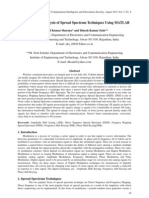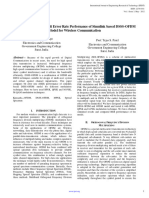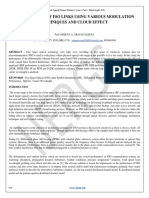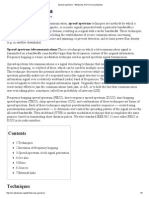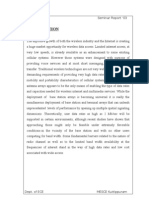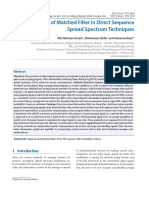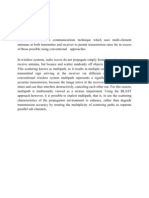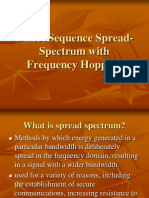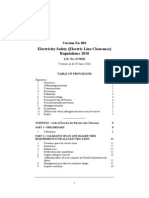0 ratings0% found this document useful (0 votes)
44 viewsImplementation of Direct Sequence Spread E2aa21ad
Implementation of Direct Sequence Spread E2aa21ad
Uploaded by
asrawi asparThis document discusses the implementation of a direct sequence spread spectrum (DSSS) communication system using a field programmable gate array (FPGA). Pseudo noise sequences are used to spread digital data across a wide frequency spectrum. The FPGA is used to generate pseudo noise sequences and implement a single user DSSS system. The pseudo noise sequences are evaluated for their autocorrelation, cross correlation, and balance properties. Bit error rate performance of the system is analyzed in a multi-user environment under additive white Gaussian noise. The DSSS system using pseudo noise sequences is shown to significantly outperform a conventional PN sequence system.
Copyright:
© All Rights Reserved
Available Formats
Download as DOCX, PDF, TXT or read online from Scribd
Implementation of Direct Sequence Spread E2aa21ad
Implementation of Direct Sequence Spread E2aa21ad
Uploaded by
asrawi aspar0 ratings0% found this document useful (0 votes)
44 views9 pagesThis document discusses the implementation of a direct sequence spread spectrum (DSSS) communication system using a field programmable gate array (FPGA). Pseudo noise sequences are used to spread digital data across a wide frequency spectrum. The FPGA is used to generate pseudo noise sequences and implement a single user DSSS system. The pseudo noise sequences are evaluated for their autocorrelation, cross correlation, and balance properties. Bit error rate performance of the system is analyzed in a multi-user environment under additive white Gaussian noise. The DSSS system using pseudo noise sequences is shown to significantly outperform a conventional PN sequence system.
Original Description:
Spread Spectrum
Original Title
239842 Implementation of Direct Sequence Spread e2aa21ad
Copyright
© © All Rights Reserved
Available Formats
DOCX, PDF, TXT or read online from Scribd
Share this document
Did you find this document useful?
Is this content inappropriate?
This document discusses the implementation of a direct sequence spread spectrum (DSSS) communication system using a field programmable gate array (FPGA). Pseudo noise sequences are used to spread digital data across a wide frequency spectrum. The FPGA is used to generate pseudo noise sequences and implement a single user DSSS system. The pseudo noise sequences are evaluated for their autocorrelation, cross correlation, and balance properties. Bit error rate performance of the system is analyzed in a multi-user environment under additive white Gaussian noise. The DSSS system using pseudo noise sequences is shown to significantly outperform a conventional PN sequence system.
Copyright:
© All Rights Reserved
Available Formats
Download as DOCX, PDF, TXT or read online from Scribd
Download as docx, pdf, or txt
0 ratings0% found this document useful (0 votes)
44 views9 pagesImplementation of Direct Sequence Spread E2aa21ad
Implementation of Direct Sequence Spread E2aa21ad
Uploaded by
asrawi asparThis document discusses the implementation of a direct sequence spread spectrum (DSSS) communication system using a field programmable gate array (FPGA). Pseudo noise sequences are used to spread digital data across a wide frequency spectrum. The FPGA is used to generate pseudo noise sequences and implement a single user DSSS system. The pseudo noise sequences are evaluated for their autocorrelation, cross correlation, and balance properties. Bit error rate performance of the system is analyzed in a multi-user environment under additive white Gaussian noise. The DSSS system using pseudo noise sequences is shown to significantly outperform a conventional PN sequence system.
Copyright:
© All Rights Reserved
Available Formats
Download as DOCX, PDF, TXT or read online from Scribd
Download as docx, pdf, or txt
You are on page 1of 9
International Journal of Advanced Engineering, Management and Science (IJAEMS) [Vol-3, Issue-5, May- 2017]
https://dx.doi.org/10.24001/ijaems.3.5.13 ISSN: 2454-1311
Implementation of Direct Sequence Spread
Spectrum Communication System Using FPGA
R.Prabhu1, R.Nagarajan2, N.Karthick3, S.Suresh4
1
Asst. Professor, Department of Electronics and Communication Engineering, Gnanamani College of Technology, Namakkal,
India.
2
Professor, Department of Electrical and Electronics Engineering, Gnanamani College of Technology, Namakkal, India.
3
Asst. Professor, Department of Electronics and Communication Engineering, Gnanamani College of Technology, Namakkal,
India.
4
Asst. Professor, Department of Electrical and Electronics Engineering, Gnanamani College of Technology, Namakkal, India
Abstract — This paper presents the designed and The ability to utilize the satellite pay load channels,
implementation of spread spectrum technology for data which is achievable as the transmitted signal is spread in
transfer to overcome the interference problems associated such a way that it become noise like and thus would not
with narrow band, very high frequency and ultra high interfere with the pay load traffic and interference limited
frequency data transfer systems. The spread spectrum operation. The security due to unknown random codes, as
communication is used to reduce jamming of the applied codes is in principle unknown to a hostile user.
communication and provides a heightened secure This means that it is not easy to possible to detect the
communication. In this paper, the design and analyzes are message of another user. Applying spread spectrum implies
implemented by Field Programmable Gate Array (FPGA) the reduction of multi path effects and random access
for baseband spread spectrum communication system possibilities. As users can start their transmission at any
using Pseudo Noise Sequences (PNS) for spreading digital arbitrary time and better anti-jam performance. The cost
data. The sequence generator and direct sequence spread paid is the need of a larger bandwidth which already present
spectrum (DSSS) for a single user is implemented in a due to the usage of the existing communication channels
FPGA module. The generated pseudo noise sequences are and the need for good synchronization at the receiver to
investigated for autocorrelation, cross correlation and detect the reception of the signal [2].
balance properties. The bit error rates performance of the The spread spectrum techniques for digital communication
system is evaluated in multiuser environment under AWGN were originally developed for military applications because
and reveals that, the DSSS system using pseudo noise of their high security and their susceptibility to interference
sequences as spreading sequences significantly from other interceptors. Now a day spread spectrum
outperforms for the conventional PN sequences system techniques are being used in variety of commercial
Keywords— Bit Error Rates (BER), Field Programmable applications such as mobile and wireless communication
Gate Array (FPGA), Direct Sequence Spread Spectrum [3]. In order to spread the bandwidth of the transmitting
(DSSS), Pseudo Noise (PN) and Spread Spectrum (SS). signals, the binary pseudo noise (PN) sequences have been
used extensively in spread spectrum communication
I. INTRODUCTION systems. One of the most commonly used PN sequences in
The spread spectrum (SS) has been defined as a means of direct sequence spread spectrum (DSSS) is maximal length
transmission in which the signal occupies bandwidth much sequences (m-sequences) [4]. The length of m-sequences
in excess of the minimum necessary to send the depends on the number of shift registers used in the circuit.
information, the band spread is accomplished by utilizing a The good correlation properties can be achieved with m-
code which is independent of the data and a synchronized sequences. The ability to predict future sequence is
reception with the code at the receiver is used for de- nevertheless possible though difficult; therefore
spreading and subsequent data recovery. The SS transmission is not completely secured [5]. The number of
communications are mostly used today for military, sequences generated by linear feedback shift registers
industrial, avionics, scientific and civil. The merits of using (LFSR) may be insufficient for wideband DSSS with a very
SS include the low power spectral density. As the signal is large number of users. In addition, LFSR techniques
spread over a large frequency band, the power spectral provide limited flexibility in incorporating security into
density is getting very low, so other communications multiple user systems [6].
systems do not suffer from this kind of communications. The use of chaotic sequences as spreading sequences has
However the Gaussian Noise level is increasing [1]. been proposed in the literature because of its sensitivity to
www.ijaems.com Page | 488
International Journal of Advanced Engineering, Management and Science (IJAEMS) [Vol-3, Issue-5, May- 2017]
https://dx.doi.org/10.24001/ijaems.3.5.13 ISSN: 2454-1311
initial conditions and has characteristics similar to random information and spread across a wide frequency spectrum.
noise. However reliable electronic hardware Any particular radio receiver will detect a single function of
implementations of chaos based PN sequence generators amplitude (voltage) vs. time [10]. The radio then uses
based on recursion of maps realized by piecewise linear a tuned circuit or tuner to select a single channel or
analogue functions and output quantization have not been frequency band and demodulate or decode the information
possible due to manufacturing process variations among from that broadcaster. If made a graph of the strength of
different integrated circuit production lots, transistor each channel vs. the frequency of the tuner, it would be the
mismatches and electronic noise [7]. The pseudo-chaotic frequency spectrum of the antenna signal [8].
sequence generator modified version is presented in this The different SS techniques are available, but all have
paper. The non linear feedback shift registers (NLFSR), one idea in common: the key (also called code or sequence)
have shown that chaotic spreading sequence can be used as attached to the communication channel. The manner of
an inexpensive alternative to the LFSR sequences such as inserting this code defines precisely the SS technique in
m-sequences and gold sequences. question. The term spread spectrum refers to the expansion
of signal bandwidth, by several orders of magnitude in
II. SPREAD SPECTRUM some cases, which occurs when a key is attached to the
The electromagnetic spectrum refers to the full range of all communication channel. The formal definition of SS is
frequencies of electromagnetic radiation and also to the more precise: spread spectrum is an RF communications
characteristic distribution of electromagnetic radiation system in which the baseband signal bandwidth is
emitted or absorbed by that particular object. The devices intentionally spread over a larger bandwidth by injecting a
used to measure an electromagnetic spectrum are called higher frequency signal [11], [12].
spectrograph or spectrometer. The visible spectrum is the As a direct consequence, energy used in transmitting the
part of the electromagnetic spectrum that can be seen by signal is spread over a wider bandwidth and appears as
the human eye. The wavelength of visible light ranges noise. The ratio (in dB) between the spread baseband and
from 390 to 700 nm. The absorption spectrum of a chemical the original signal is called processing gain. The typical SS
element or chemical compound is the spectrum of processing gains run from 10dB to 60dB. To apply an SS
frequencies or wave lengths of incident radiation. technique, simply inject the corresponding SS code
The emission spectrum refers to the spectrum of radiation somewhere in the transmitting chain before the antenna,
emitted due to an atom or molecule making that injection is called the spreading operation. The effect is
a transition from a higher to a lower energy state. The light to diffuse the information in a larger bandwidth.
from many different sources contains various colors, each Conversely, can remove the SS code (dispreading
with its own brightness or intensity. A rainbow, or prism, operation) at a point in the receive chain before data
sends these component colors in different directions, retrieval. The effect of a dispreading operation is to
making them individually visible at different angles [8]. reconstitute the information in its original bandwidth.
The graph of the intensity plotted against the frequency Obviously, the same code must be known in advance at
showing the brightness of each color is the frequency both ends of the transmission channel [13]. The spread
spectrum of the light. When all the visible frequencies are spectrum operation diagram is shown in Figure 1.
present equally, the perceived color of the light is white,
and the spectrum is a flat line. Therefore, the flat line
spectrums in general are often referred to as white, whether
they represent light or another type of wave phenomenon
(sound, for example, or vibration in a structure). In radio
and telecommunications, the frequency spectrum can be
shared among many different broadcasters [9].
The radio spectrum is the part of the electromagnetic
spectrum corresponding to frequencies lower below
300 GHz, which corresponds to wavelengths longer than
about 1 mm. The microwave spectrum corresponds to
frequencies between 300 MHz to 300 GHz, wavelength Fig.1: Spread Spectrum
between the distances of one meter to one millimeter. Each
broadcast radio and TV station transmits a wave on an The quadrature phase shift keying (QPSK) uses four points
assigned frequency range, called a channel. When many on the constellation, equispaced around a circle with four
broadcasters are present, the radio spectrum consists of the phases; QPSK can encode two bits per symbol, with gray
sum of all the individual channels, each carrying separate coding to minimize the BER sometimes misperceived as
www.ijaems.com Page | 489
International Journal of Advanced Engineering, Management and Science (IJAEMS) [Vol-3, Issue-5, May- 2017]
https://dx.doi.org/10.24001/ijaems.3.5.13 ISSN: 2454-1311
twice the BER of binary phase shift keying (BPSK). The system of sequences used in spread spectrum
mathematical analysis shows that QPSK can be used either communication is usually periodic in that a sequence of
to double the data rate compared with a BPSK system while 1’s and 0’s repeats itself exactly with a known period. The
maintaining the same bandwidth of the signal, or m-sequence represents a commonly used periodic PN
to maintain the data rate of the BPSK but halving the sequence. Such sequences are long periods and require
bandwidth needed. In this latter case, the BER of QPSK is simple instrumentation in the form of a LFSR. Indeed,
exactly the same as the BER of BPSK and deciding they possess the longest possible period for this method of
differently is a common confusion when considering or generation [16]. The generated m-sequence is always
describing QPSK. The transmitted carrier can undergo periodic with a period of N=2��-1 where m indicates is the
numbers of phase changes [14]. length of the shift register. The Figure 2 shows the block
The given radio communication channels are allocated by diagram of PN Sequence Generator.
agencies such as Federal Communication
Commission giving a prescribed (maximum) bandwidth,
the advantage of QPSK over BPSK becomes evident: the
QPSK transmits twice the data rate in a given bandwidth
compared to BPSK - at the same BER. The engineering
penalty that is paid is that QPSK transmitters and receivers
are more complicated than the ones for BPSK. However,
with modern electronics technology, the penalty in cost is
very moderate [15].
As with BPSK, there are phase ambiguity problems at the
receiving end, and differentially encoded QPSK is often
used in practice. The implementation of QPSK is more Figure 2 Block Diagram of PN Sequence Generator
general than that of BPSK and also indicates the
implementation of higher order PSK. Writing the symbols There are many types of spread spectrum techniques as:
in the constellation diagram in terms of the sine and cosine Direct sequence, frequency hopping, time hopping and
waves used to transmit them: hybrid system. The direct sequence contrasts with the other
spread spectrum process, in which a broad slice of the
bandwidth spectrum is divided into many possible
broadcast frequencies. In general, frequency hopping
devices use less power and are cheaper, but the
This yields the four phase’s π/4, 3π/4, 5π/4 and 7π/4 as performance of DS-CDMA systems is usually more
needed. This results in a two-dimensional signal space with reliable. Thus, in this paper deal only with direct sequence
unit basis functions spread spectrum method. In direct sequence spread
spectrum the base-band waveform is XOR by the PNS
sequence in order to spread the signal. After spreading, the
signal is modulated and transmitted [17], [18].
The first basis function is used as the in-phase
component of the signal and the second as the quadrature
component of the signal. Hence, the signal constellation
consists of the signal-space 4 points. The factors of 1/2
indicate that the total power is split equally between the two
carriers. Comparing these basis functions with that for
BPSK show clearly how QPSK can be viewed as two
independent BPSK signals [3]. Fig.3: Block Diagram of DSSS
III. DIRECT SEQUENCE SPREAD SPECTRUM The Figure 3 shows the block diagram of DSSS. The
The Pseudo Noise (PN) is defined as a coded sequence of bandwidth expansion factor also called the processing gain
1’s and 0’s with certain auto correlation properties. The (K), can be defined as the ratio between the transmitted
www.ijaems.com Page | 490
International Journal of Advanced Engineering, Management and Science (IJAEMS) [Vol-3, Issue-5, May- 2017]
https://dx.doi.org/10.24001/ijaems.3.5.13 ISSN: 2454-1311
spread spectrum signal bandwidth (B) and the bandwidth of corresponding registers R1 to R8 are selected. The 8 bit
the original data sequence (B message) where the initial values to each of these 8 registers are loaded using 8
processing gain is nearly the ratio of the spread bandwidth pin of the register unit [23].
to the information rate R (bits/s) and it is much greater than After loading the initial values to all the 8 registers, ready
unity. The spread spectrum transmitter use similar transmits out pin gives a signal to the user. At the same time a signal
power levels to narrow band transmitters. Because spread ready is set to high which gives an indication to the control
spectrum signals are so wide, they transmit at a much lower circuit that it can start its operation. Initially before loading
spectral power density, than narrow band transmitters. The the initial values to the registers R1 to R8, the control
spread and narrow band signals can occupy the same band, circuit signals busy and done are not enabled i.e., busy =1
with little or no interference. The interference rejection and done=0. As soon as ready=1, then the signal busy=0.
capability arises from low mutual correlation between the The tracking and synchronization of the receiver can be
desired signal and the interfering signal ensured by the done easily by sending first 8 bit data as “11111111”. In
codes [19], [20]. that condition, the massage source sends a signal in the
This capability is the main reason for all the interest in form of reload signal to the control circuit to indicate that
spread spectrum today. The given equation represents the it is ready to send the data. Once this is happens the 8 bit
DSSS signal. data is sent parallels and stored in a buffer register of
Sss = √ (2 Es/Ts) [m(t) ⊗ p(t)] cos (2 π fc t + θ ) control circuit in the next clock cycle [24].
Where:
m(t) is the data sequence,
Ts is duration of data symbol.
p(t) is the PCS spreading sequence,
fc is the carrier frequency,
θ is the carrier phase angle at t=0
The spread spectrum having the following advantages such
as: jamming resistance for intended or unintended jamming.
A single channel is shared among multiple users.
Interception is hampered due to reduced signal/background
noise level. The relative timing between transmitter and
receiver is determined. In DSSS a sine wave is pseudo
randomly phase modulated with a continuous string of
pseudo noise code symbols called "chips", each of these Fig.4: Block Diagram of Transmitter
chips has a much shorter duration than an information bit.
In effect information signal is modulated by chips sequence After receiving the 8 bit data frame, the control circuit
which is much faster. Therefore, the chip rate is much enables the PCS generator by setting the signal run=1, also
higher than information signal bit rate. In DSSS the chip enables the multiplier by setting enable=1 and indicates the
sequences produced by the transmitter to modulate the buffer that it is busy by setting the signal busy=1. During
signal is known at receiver end and receiver uses the same this time the PCS generator starts generating the 32-bits of
chip sequences to demodulate [21], [22]. PCS sequence. The control circuit then transfers one bit at
a time serially to the multiplier where it is multiplied by
IV. FPGA IMPLEMENTATION OF DSSS the 32-bits of generated PCS sequence resulting in a 32-
SYSTEM bits of spread sequence and the same is transmitted. After
In this paper, the conventional PN sequence system is the first data bit is spread by 32-bits of PCS sequence, the
replaced by PCS (pseudo-chaotic sequence) for a DSSS second data bit is received in the multiplier and is
system. The block diagram of the implemented DSSS multiplied by the next 32-bits of the PCS sequence. Hence
system with transmitter and receiver, and inter connection the PCS generator generates a total of 256 bits to spread all
between them is shown in Figure 3. In this Figure 3 shows the 8-bits of data. After transmitting all the 256 bits with
that channel is the only connection between transmitter and respect to one frame of data i.e., 8-bits of data, the control
receiver; assuming clock has been synchronized and circuit makes signal done=1 and busy=0. At that time the
channel is ideal. In this DSSS system, we spread the data control circuit is ready to accept next frame of 8-bits of
bits using PCS sequence which are generated by using PCS data. In this way the operation of the transmitter repeats
generator. To generate PCS sequence, need to initialize the and maintains the gap between the two frames. The Figure
8 bit registers R1 to R8 of PCS generator. To load eight 4 shows the block diagram of transmitter [25].
registers of the PCS generator to set load=1 and the
www.ijaems.com Page | 491
International Journal of Advanced Engineering, Management and Science (IJAEMS) [Vol-3, Issue-5, May- 2017]
https://dx.doi.org/10.24001/ijaems.3.5.13 ISSN: 2454-1311
The internal block diagram of the receiver is shown in the parts back into the original sequence in case they are
Figure 5. It consists of detector, control circuit, PCS shuffled out of order. The splitting and aggregating the
generator and demodulator. The receiver mainly works in message is especially useful when you intend to process the
3 phases: the training phase, the detection phase, and the split parts in asynchronous flows running on separate
dispreading phase. Before the training phase, the 8 bit servers. Together, the splitter and aggregator flow controls
registers R1 to R8 are again initialized with the same allow sharing the workload among several servers and still
initial values used in the transmitter. This is indicated by being able to reassemble the message after its process.
setting ready =1 by the PCS generator to the control In this address generator block was generate the two bit
circuit. During the training phase the control circuit keeps address for each cycle in this address generator using for
the signal ld=1 and enable=0 and run=1. Now the detector counter logic function .first the counter initial position is
is initialized with a training sequence i.e., the first 256 bits ‘0’ when we give enable signal means that time will start
of the PCS sequence are loaded into the 8 lower registers, for count that was generate for continues two bit address
each with 32-bits of the detector. In the detection phase, for each clock. The control unit was control the input
the control circuit resets ld=0 and run=0. During this phase message signal .the control unit was controlled by the
the received data of 256 bits are loaded into the upper 8 carrier wave generator. The DSSS technique was basically
registers of detector, each register with 32-bits and is using for four types of carrier signal there are, Sine wave,
compared with the bit pattern which is already stored in Inv-sine wave, Cos wave and Inv-cos wave. The carrier
the lower 8 registers of the detector [26]. wave fully generated after that give one enable signal for
. each carrier signal any one signal was reach to the control
unit means the control unit was using for XOR logic
function [27].
The definition of proper sampling is quite simple. Suppose
the sample is a continuous signal in some manner. If you
can exactly reconstruct the analog signal from the samples,
you must have done the sampling properly, even if the
sampled data appears confusing or incomplete. In the
analog signal is a constant DC value, a cosine wave
of zero frequency. Since the analog signal is a series of
Fig.5: Block Diagram of Receiver straight lines between each of the samples, all of the
information needed to reconstruct the analog signal is
The spread spectrum technology is a new type of data contained in the digital data. According to our definition,
transfer designed to overcome the interference problems this is proper sampling, the sine wave frequency of 0.09 of
associated with narrow-band very high frequency and the sampling rate. This might represent, for example, a 90
ultrahigh frequency data transfer systems. The spread cycle/second, the sine wave being sampled at 1000
spectrum communication is used to reduce jamming of samples/second. Expressed in another way, there are 11.1
communication and provides a heightened secure samples taken over each complete cycle of the sinusoid
communication. In this paper we specifies the design and wave. These samples correspond to only one analog signal,
Field Programmable Gate Array (FPGA) implementation and therefore the analog signal can be exactly
of a baseband spread spectrum communication system reconstructed, again, an instance of proper sampling. The
using Pseudo-Noise Sequences (PNS) for spreading digital situation is made more difficult by increasing the sine
data. wave's frequency to 0.31 of the sampling rate [28].
In this paper there are eight bit input massage signal are
used. The splitter block in the circuit split the message
signal for two bits for each clock cycle to produce two
message signals. Hear the splitter block using multiplexer
logic function. The splitter flow control splits a message
into separate fragments, and then sends these fragments one
at a time to the next message processor in the flow. The
segments are identified based on an expression parameter,
usually written in Mule expression language (MEL), but
other formats can be employed also. The collection Fig.6: Carrier Wave Generators
aggregator flow control is used to reassemble the parts of
the original message. the re-sequencer flow control to put
www.ijaems.com Page | 492
International Journal of Advanced Engineering, Management and Science (IJAEMS) [Vol-3, Issue-5, May- 2017]
https://dx.doi.org/10.24001/ijaems.3.5.13 ISSN: 2454-1311
The Figure 6 shows the Carrier Wave Generators. The In our project we go for store the incoming carrier wave to
sampling theorem indicates that a continuous signal can be demodulate process. Why we go for ROM here we are
properly sampled, only if it does not contain frequency already store the signal value according to transmission of
components above one-half of the sampling rate. For the carrier signal for avoid the transmission cycle only.
instance, a sampling rate of 2,000samples/second requires here our project we store the 256byte of sample values of
the analog signal to be composed of frequencies below our carrier signal .here we can decide which set of signal
1000 cycles/second. If frequencies above this first go to the correlator block. The signal is taken out as
limit are present in the signal, they will be aliased to per the carrier transmission. The ROM is constructed in
frequencies between 0 and 1000 cycles/second, combining two dimension array. The width is 8 bit and depth is 256
with whatever information that was legitimately there. byte. Here we store the 256 byte of samples which is
transmitted in the transmitter side. The function is when
we receive the signal it will stored in ROM. After that
Where: every clock when reset is disabling it will send 64 bit of
A= Amplitude of the deviation function from zero. data as a output. The ROM hold 256 byte of sample values
f = Frequency of oscillations (cycles) that occur each so it has 2048 bit values.it will send 64 bit per clock cycle.
second Then the output is goes to the correlator block.
ω =2πf, the angular frequency, the rate of change of the The device used is known as correlator or detector. In this
function argument in units of radians per second project, we have used a modified version of conventional
φ = phase, specifies (in radians) where in its cycle the detector at the receiver to detect the signal from the
oscillation is at t =0. transmitter and to achieve synchronization between the
In electronics, a multiplexer (or mux) is a device that transmitter and receiver during the communication in
selects one of several analog or digital input signals and DSSS system that uses PN sequence. The detection of
forwards the selected input into a single line. A signal from the intended transmitter at receiver and to
multiplexer of 2n inputs has n select lines, which are used achieve the synchronization between them is very
to select which input line to send to the important in DSSS system specifically when the system
output. Multiplexers are mainly used to increase the uses pseudo noise sequence. The correlator is constructed
amount of data that can be sent over the network within a by multiplier with adder. When the input signal is received
certain amount of time and bandwidth. A multiplexer is from ROM it will split in to 8 bits. It will receive 64 byte
also called a data selector. Multiplexers can also be used to of data and split the 64 byte of data and multiply with
implement Boolean functions of multiple variables. An carrier signal samples to every byte data. Finally using
electronic multiplexer makes it possible for several signals adder we will add all the results. So we get 16 bit as a
to share one device or resource, for example one or one output.
communication line, instead of having one device per The comparator is used to compare the output value of
input signal. Conversely, a de multiplexer (or de mux) is a correlator block. it compare the four set carrier signals and
device taking a single input signal and selecting one of given to a two bit of output .it will receive a 14 bit of input
many data-output-lines, which is connected to the single the comparator has already known four set constant value,
input. A multiplexer is often used with a complementary so that the comparator compare the input value with the
de multiplexer on the receiving end. An electronic constant output, from that it will send a 2 bit of output, the
multiplexer can be considered as a multiple-input, single- out is goes to the shifter block. The shifter is a sequential
output switch, and a de multiplexer as a single-input, circuit; it is constructed by flip-flops or registers. In this
multiple-output switch [29]. circuit using 8 bit left shift registers for design. The shift
The binary information that is stored within such a device registers is used to shift the input data and store the all 8
is specified in some fashion and then embedded within the bit data. It will send the output when the 8 bits are received
hardware in a process is referred to as programming the from the comparator. When the reset is disable it will
device. The word “programming” here refers to a hardware receive the first two bit of input and shift two positions to
procedure which specifies the bits that are inserted into the the left at the second clock, it will receive another two bit
hardware configuration of the device.ROM is one example of input and shit two bit to the left side. Then it will
of a PLD. Other such units are the Programmable Logic receive another two bit. The same process repeats at the
Array (PLA), Programmable Array Logic (PAL), and the fourth clock it will receive the last two bits of value it will
Field‐Programmable Gate Array (FPGA). A PLD is an shift again two bit and to the output of 8 bits. In our design
integrated circuit with internal logic gates connected shift registers is used in asynchronous clock.
through electronic circuits [30]. Here we generate the same PN sequence already generated
in the transmitter nodule. The PN sequence generator has
www.ijaems.com Page | 493
International Journal of Advanced Engineering, Management and Science (IJAEMS) [Vol-3, Issue-5, May- 2017]
https://dx.doi.org/10.24001/ijaems.3.5.13 ISSN: 2454-1311
the seed bit, which is act as our security key. Without PN
sequence we cannot encrypt our original message signal.
In general, the PN sequence generated by a polynomial
equation. The LFSR (linear feedback shift register) is used
to generate the PN sequence but here using a XOR gate
only for generating PN sequence in the data flow model. In
this design the PN generator with only using XOR gates. It
is one of the basic gates. The output is high when the both
inputs are not equal. The output is zero if the inputs are Fig. 7(d): Correlator Waveform
same. Here XOR gate is used to mix the input signal with
the pseudo noise signal. The XOR gate receive the two
inputs one from the shifter block another one from the PN
sequence generator, shifter block output is 8 bit. PN
sequence output is 8 bit it will XOR the both the inputs
then it will give the output as 8 bit; this is what our
original message signal. Finally we get our original
message signal. The XOR gate gives the original message
signal. Here the PN sequence seed bit is keep it as Fig. 7(e): Receiver Waveform
confidential. So finally get the original message signal
using of direct sequence spread spectrum. VI. CONCLUSION
In this paper, The PCS generator is discussed based on the
V. SIMULATION RESULTS model. The initial conditions of the PCS sequence
Figure 7(a), (b), (c), (d) and (e) show the simulation results generators can be randomly selected to produce pseudo-
of the direct sequence spread spectrum, Carrier signal, chaotic sequence with good correlation properties upon
transmitter final waveform, ROM waveform, correlator exhaustive comparison to be distinct sequences rather than
waveform and receiver waveform. phases of the same sequence. The family of pseudo chaotic
PN sequences proved good correlation properties than
conventional m-sequences and hence it can be useful for
DSSS. The Pseudo chaotic sequence generation with its
robust digital implementation is to avoid many difficulties
associated with analog chaotic circuits. The large set of
system parameters (initial conditions and internal
configuration of cells and generators) and the non linear
Fig. 7(a): Carrier Signal nature of the feedback generation circuitry lead to potential
applications for programmable secure communication
systems. The tests will have shown that simply using
random selections of initial conditions can provide pseudo
chaotic PN sequences that are relatively long with good
correlation properties. Based on these results it is worth
noting that the sequences based on quantized maps derive
many of their statistical properties from the specific
architectures used to implement them. This flexibility
Fig. 7(b): Transmitter Final Waveform provides an additional level of security on top of the
inherent low probability of intercept characteristics of PN
sequences due to the difficulty of identify the underlying
structure. Therefore the number of implementation
possibilities is very high due to initial condition
programmability, can be made software controlled and this
new system of sequences is inherently less difficult to
detect.
Fig. 7(c): ROM Waveform
www.ijaems.com Page | 494
International Journal of Advanced Engineering, Management and Science (IJAEMS) [Vol-3, Issue-5, May- 2017]
https://dx.doi.org/10.24001/ijaems.3.5.13 ISSN: 2454-1311
REFERENCES Emerging Technologies in Engineering Research
[1] John G. Prokis : Digital communications. Mc. Graw (IJETER), Volume 5, Issue 5, pp. 41- 45, May-2017.
Hill [12] R.Nagarajan and M,Saravanan. “Performance
[2] G. Vidhya Krishnan, R.Nagarajan, T. Durka, Analysis of a Novel Reduced Switch Cascaded
M.Kalaiselvi, M.Pushpa and S. Shanmuga Multilevel Inverter,” Journal of Power Electronics,
priya, "Vehicle Communication System Using Li-Fi Vol.14, No.1, pp. 48-60. Jan. 2014.
Technology," International Journal of Engineering [13] Haykin,S. “Communication Systems,” 4th Edition.
And Computer Science (IJECS), Volume 6, Issue 3, New York: John Wiley and Sons, 2001
pp. 20651-20657, March 2017. [14] R.Nagarajan and M,Saravanan “Staircase
[3] J.Chandramohan, R.Nagarajan, K.Satheeshkumar, Multicarrier SPWM Technique for Nine Level
N.Ajithkumar, P.A.Gopinath and S.Ranjithkumar, Cascaded Inverter,” Proceedings of the International
"Intelligent Smart Home Automation and Security Conference on Power, Energy and Control, IEEE
System Using Arduino and Wi-fi," Press, pp. 668-675. 2013.
International Journal of Engineering And Computer [15] Y.Soobul, K.Chady, Harry, C.S.Rughoopath “Digital
Science (IJECS), Volume 6, Issue 3, pp. 20694- chaotic coding and modulation in CDMA,” Proc. of
20698, March 2017. IEEE Africon, pp. 841-846. 2002.
[4] G.Heidari-Bateni,C.D. Mc-Gillem, "Chaotic [16] Bernard Sklar “Digital communication.
sequences for spread spectrum: An alternative to PN Fundamentals and Applications, Prentice Hall. 2001.
sequences" Proc. IEEE ICWC- 92437 C 440,1992 [17] R.Nagarajan, S.Sathishkumar, S.Deepika,G.Keerthan
[5] J.Chandramohan, R.Nagarajan, M.Ashok kumar, a,J.K.Kiruthika and R.Nandhini, "Implementation of
T.Dineshkumar, G.Kannan and R.Prakash, Chopper Fed Speed Control of Separately Excited
“Attendance Monitoring System of Students Based DC Motor Using PI Controller," International Journal
on Biometric and GPS Tracking System,” of Engineering And Computer Science (IJECS),
International Journal of Advanced Engineering, Volume 6, Issue 3, pp. 20629-20633, March 2017.
Management and Science (IJAEMS), Vol-3.Issue-3, [18] Ajeesh P. Kurian, Sadasivan Puthusserypady, Su
pp. 241-246, Mar. 2017. Myat Htut, "performance enhancement of DS/CDMA
[6] R.Nagarajan, S.Sathishkumar, K.Balasubramani, system using chaotic complex spreading sequence",
C.Boobalan, S.Naveen and N.Sridhar. “Chopper Fed IEEE Trans. nn Wireless communication. 4 (3), pp.
Speed Control of DC Motor Using PI Controller,” 984 - 989, 2005.
IOSR- Journal of Electrical and Electronics [19] R.Nagarajan, R.Yuvaraj, V.Hemalatha, S.Logapriya,
Engineering (IOSR-JEEE), Volume 11, Issue 3, Ver. A.Mekala and S.Priyanga, "Implementation of PV -
I, pp. 65-69, May – Jun. 2016. Based Boost Converter Using PI Controller with
[7] Leon.D, S.Balkir,M.W. Hoffman, l. C. Perez, PSO Algorithm," International Journal of
“Pseudo-chaotic PN sequence generators circuits for Engineering And Computer Science (IJECS),
SS communication,” Proc. of IEE Circuits Dev. Volume 6, Issue 3, pp. 20479-20484, March, 2017.
Syst.151(6), pp. 543-550 (2004) [20] Bob X. LI, Simon Haykin, "A new pseudo - noise
[8] K. Anandhi and Dr. R. Nagarajan, “Mutex-Heart: generator for spread spectrum communication", Proc.
Fail Safe Dual Chamber Cardiac Pacemaker Device of IEEE. Pp. 3603-3606, 1995.
with Rate Responsive Control and Cryptographic [21] Ms. C. Hemalatha, Mr. R. Nagarajan, P. Suresh, G.
Security,” IJSRD - International Journal for Scientific Ganesh Shankar and A. Vijay, “Brushless DC Motor
Research & Development. Vol. 3, Issue - 2, pp. 489- Controlled by using Internet of Things,” IJSTE -
493, 2015. International Journal of Science Technology &
[9] Lathi, B.P. “Modern Digital and Analog Engineering, Volume 3. Issue 09, pp. 373-377,
Communications Systems,” 3rd Edition. New York: March- 2017.
Oxford University Press. 1998 [22] Youssef.M. I, M. Zahara, A. E. Emam, and M.
[10] R.Nagarajan, J.Chandramohan, R.Yuvaraj, AbdElGhany, “Chaotic Sequence Implementation on
S.Sathishkumar and S.Chandran, “Performance Residue Number Spread Spectrum,” International
Analysis of Synchronous SEPIC Converter for a Journal of Communication, Volume 2, Issue2, 2008,
Stand-Alone PV System,” International Journal of [23] S.Suresh, R.Nagarajan, L.Sakthivel, V.Logesh,
Emerging Technologies in Engineering Research C.Mohandass and G.Tamilselvan, “Transmission
(IJETER), Volume 5, Issue 5, pp. 12-16, May-2017. Line Fault Monitoring and Identification System by
[11] M.Padmavathi and R.Nagarajan, “Smart Intelligent Using Internet of Things,” International Journal of
ATM Using LABVIEW,” International Journal of
www.ijaems.com Page | 495
International Journal of Advanced Engineering, Management and Science (IJAEMS) [Vol-3, Issue-5, May- 2017]
https://dx.doi.org/10.24001/ijaems.3.5.13 ISSN: 2454-1311
Advanced Engineering Research and Science
(IJAERS), Vol-4.Issue-4, pp. 9-14, Apr- 2017.
[24] C.Vladeanu, I.Banica, S.El Assad, “Periodic chaotic
spreading sequences with better correlation properties
than conventional sequences - BER performance
analysis,” Proc. of IEEE Int. Symp. On Signals,
circuits and systems. Pp. 649-652, 2003.
[25] A.Mahendran, K.Muthulakshmi and R.Nagarajan,
“Triangular Multicarrier SPWM Technique for Nine
Level Cascaded Inverter,” International Journal of
Scientific & Engineering Research, Vol.4, No.5, pp.
269-275, May-2013.
[26] SuMyat Htut, Sadasivan Puthusserypady, “A Novel
CDP DS/SS System with 2-Dimensional Ikeda map
chaoticsequence,” Proc. of IEEE Int. Symposium on
Personal, Indoor and Mobile Radio communication.
Pp. 2734-2738, 2003.
[27] R.Nagarajan and M,Saravanan, “A Carrier - Based
Pulse Width Modulation Control Strategies for
Cascaded Multilevel Inverter,” International Review
on Modeling and Simulations (IRMOS), Vol 6.No1,
pp-8-19, Feb. 2013.
[28] C.Vladeanu,I .Banica, “Performanceof Multistage
Detectors for DS-CDMA Systems,” Proc of IEEE-
ICT. Pp. 35-39, 2001.
[29] S. Chandrasekar and Gian Carlo Montanari,
“Analysis of Partial Discharge Characteristics of
Natural Esters as Dielectric Fluid for Electric Power
Apparatus Applications,” IEEE Transactions on
Dielectrics and Electrical Insulation Vol. 21, No. 3,
pp.1251-1259 June 2014.
[30] R.Nagarajan and M, Saravanan, “Comparison of
PWM Control Techniques for Cascaded Multilevel
Inverter” International Review of Automatic control
(IRACO), Vol.5, No.6, pp. 815-828. Nov. 2012.
www.ijaems.com Page | 496
You might also like
- Implementation of Spread Spectrum Modulation Schemes For Secure CommunicationsDocument5 pagesImplementation of Spread Spectrum Modulation Schemes For Secure Communicationsdonishakumar15No ratings yet
- Performance Analysis of Spread Spectrum TechniquesDocument5 pagesPerformance Analysis of Spread Spectrum TechniquesjtmagpocNo ratings yet
- Paper-4 - Simulation and Analysis of Spread Spectrum Techniques Using MATLABDocument6 pagesPaper-4 - Simulation and Analysis of Spread Spectrum Techniques Using MATLABRachel Wheeler100% (2)
- Tugas Spread SpectrumDocument7 pagesTugas Spread SpectrumShidqi PranitiNo ratings yet
- DSSS BPSKDocument48 pagesDSSS BPSKEmy Jacob100% (2)
- Lecture 1 - Spread Spectrum2Document69 pagesLecture 1 - Spread Spectrum2Qasim HadiNo ratings yet
- V1i3 Ijertv1is3008Document5 pagesV1i3 Ijertv1is3008evia jhonNo ratings yet
- Performance of Fso Links Using Various Modulation Techniques and Cloud EffectDocument6 pagesPerformance of Fso Links Using Various Modulation Techniques and Cloud EffectJabeena AfthabNo ratings yet
- Gold Seq ProjectDocument23 pagesGold Seq ProjectMostafa ZakyNo ratings yet
- Report On FHSS and DHSSDocument16 pagesReport On FHSS and DHSSKushNo ratings yet
- Multiple Carriers in Wireless Communications - : Curse or Blessing?Document9 pagesMultiple Carriers in Wireless Communications - : Curse or Blessing?Amit ShivhareNo ratings yet
- Spread Spectrum - Wikipedia, The Free EncyclopediaDocument5 pagesSpread Spectrum - Wikipedia, The Free EncyclopediaMuhammad MohsinNo ratings yet
- AJERD1103-18-22Document5 pagesAJERD1103-18-22abdulwahabgiwaNo ratings yet
- Blast Seminar ReportDocument23 pagesBlast Seminar ReportArpit DhawanNo ratings yet
- An Introduction To Spread-Spectrum CommunicationsDocument12 pagesAn Introduction To Spread-Spectrum CommunicationsAli KashiNo ratings yet
- Spreading Sequence Design For Multirelay NetworksDocument6 pagesSpreading Sequence Design For Multirelay NetworksIJIRSTNo ratings yet
- BER Analysis For Quadrature Amplitude Modulation in MIMO OFDM System Ijariie4460Document12 pagesBER Analysis For Quadrature Amplitude Modulation in MIMO OFDM System Ijariie4460Yimelis EndeshawNo ratings yet
- Literature Survey of Direct Sequence Spread Spectrum SystemDocument10 pagesLiterature Survey of Direct Sequence Spread Spectrum SystemDheyauldeen NajimNo ratings yet
- Direct-Sequence Spread Spectrum: From Wikipedia, The Free EncyclopediaDocument3 pagesDirect-Sequence Spread Spectrum: From Wikipedia, The Free EncyclopediafiraszekiNo ratings yet
- Fast Fourier Transform of Frequency Hopping Spread Spectrum in Noisy EnvironmentDocument5 pagesFast Fourier Transform of Frequency Hopping Spread Spectrum in Noisy EnvironmentNaveed RamzanNo ratings yet
- Performance Analysis of Spread Spectrum System (Direct Sequence) Over Fading Channel Models - and Multi-Carrier CDMADocument18 pagesPerformance Analysis of Spread Spectrum System (Direct Sequence) Over Fading Channel Models - and Multi-Carrier CDMAMounesh PanchalNo ratings yet
- The Rake ReceiverDocument17 pagesThe Rake ReceiverkoreaatulNo ratings yet
- 5314sipij06 PDFDocument11 pages5314sipij06 PDFelhamNo ratings yet
- 参量混频双光梳信道化接收机Document9 pages参量混频双光梳信道化接收机Gosoviet XINGNo ratings yet
- Subjective 1) What Is Encapsulation? Discuss Generic Routing EncapsulationDocument6 pagesSubjective 1) What Is Encapsulation? Discuss Generic Routing EncapsulationShannon GonsalvesNo ratings yet
- PC 2 PC Laser Communication SystemDocument3 pagesPC 2 PC Laser Communication SystemMamun LimonNo ratings yet
- Optimization of BER in Cognitive Radio Networks Using FHSS and Energy-Efficient OBRMB Spectrum SensingDocument40 pagesOptimization of BER in Cognitive Radio Networks Using FHSS and Energy-Efficient OBRMB Spectrum SensingmkmanojdevilNo ratings yet
- Ijcet: International Journal of Computer Engineering & Technology (Ijcet)Document14 pagesIjcet: International Journal of Computer Engineering & Technology (Ijcet)IAEME PublicationNo ratings yet
- Channel Sounding CONNECT2013Document7 pagesChannel Sounding CONNECT2013Marcelo NunesNo ratings yet
- Analysis of Energy Detection Spectrum Sensing Technique in Cognitive RadioDocument53 pagesAnalysis of Energy Detection Spectrum Sensing Technique in Cognitive RadiodileeppatraNo ratings yet
- Spread Spectrum - WikipediaDocument4 pagesSpread Spectrum - WikipediaabredulebreNo ratings yet
- Performance Evaluation of Different Frequency Bands of Wimax and Their Selection ProcedureDocument18 pagesPerformance Evaluation of Different Frequency Bands of Wimax and Their Selection ProcedureVigneshInfotechNo ratings yet
- Blast: College of Engineering Perumon 1 Dept. of Electronics & CommunicationDocument23 pagesBlast: College of Engineering Perumon 1 Dept. of Electronics & CommunicationInduchoodan RajendranNo ratings yet
- 21EC51 DC Module 3Document36 pages21EC51 DC Module 3adnagaprasadNo ratings yet
- Cognitive Radio: Varun Saxena, Ajay Kumar YadavDocument3 pagesCognitive Radio: Varun Saxena, Ajay Kumar YadaverpublicationNo ratings yet
- UWB Mengali ChannelEstimationDocument9 pagesUWB Mengali ChannelEstimationJamil AhmadNo ratings yet
- Experimental Study of Umts Radio Signal Propagation Characteristics by Field MeasurementDocument8 pagesExperimental Study of Umts Radio Signal Propagation Characteristics by Field MeasurementAJER JOURNALNo ratings yet
- Ijettcs 2014 06 14 086Document5 pagesIjettcs 2014 06 14 086International Journal of Application or Innovation in Engineering & ManagementNo ratings yet
- Introduction To Spread SpectrumDocument8 pagesIntroduction To Spread SpectrumTim Kabi100% (1)
- Spread Spectrum CommunicationsDocument4 pagesSpread Spectrum CommunicationsNoor AlharegiNo ratings yet
- Matched Filter PaperDocument7 pagesMatched Filter PaperAlex Krockas Botamas ChonnaNo ratings yet
- Spread Spectrum CODES-DSSS (Direct Sequence Spread Spectrum) &FHSSS (Frequency Hopping Sequence Spread Spectrum)Document26 pagesSpread Spectrum CODES-DSSS (Direct Sequence Spread Spectrum) &FHSSS (Frequency Hopping Sequence Spread Spectrum)Errabelly Anudeep RaoNo ratings yet
- BlastDocument12 pagesBlastlitttleNo ratings yet
- Technical Seminar Report: ON BlastDocument30 pagesTechnical Seminar Report: ON BlastIshank AsijaNo ratings yet
- 2021 Stochastic Geometry Based Interference Analysis of Multiuser Mmwave Networks With RISDocument6 pages2021 Stochastic Geometry Based Interference Analysis of Multiuser Mmwave Networks With RISJosue MelongNo ratings yet
- Direct Sequence Spread Spectrum With Barker Code and QPSK: Saed ThuneibatDocument6 pagesDirect Sequence Spread Spectrum With Barker Code and QPSK: Saed ThuneibatAdit SoodNo ratings yet
- Jicable DAS For Power Industry Applications 2015-A3-4Document6 pagesJicable DAS For Power Industry Applications 2015-A3-4Richard KluthNo ratings yet
- Direct Sequence Spread-Spectrum With Frequency HoppingDocument30 pagesDirect Sequence Spread-Spectrum With Frequency HoppingMaki-Bum MaharotNo ratings yet
- Maharashtra State Board of Technical Education 008Document12 pagesMaharashtra State Board of Technical Education 008Siddhart KadamNo ratings yet
- 2002 - FSO For Next GenerationDocument5 pages2002 - FSO For Next GenerationDiogo FontanaNo ratings yet
- V4i3 1439Document5 pagesV4i3 1439NathaNo ratings yet
- Cdma DsssDocument6 pagesCdma DsssSh Re SuNo ratings yet
- Spread Spectrum in Mobile Computing - JavatpointDocument9 pagesSpread Spectrum in Mobile Computing - Javatpointjulie MNo ratings yet
- Spread Spectrum Multiple AccessDocument6 pagesSpread Spectrum Multiple AccessgauravsanadhyaNo ratings yet
- A Nobel Approach For Entropy Reduction of Wireless Sensor NetworksDocument5 pagesA Nobel Approach For Entropy Reduction of Wireless Sensor NetworksEditor IJRITCCNo ratings yet
- Software-Defined Radio (SDR)Document5 pagesSoftware-Defined Radio (SDR)Lan-HekaryNo ratings yet
- Ranging in Multiband Ultrawideband Communication SystemsDocument8 pagesRanging in Multiband Ultrawideband Communication SystemsRAJKUMAR SAMIKKANNUNo ratings yet
- Pulse Generation and Analysis of Ultra Wide Band System ModelDocument4 pagesPulse Generation and Analysis of Ultra Wide Band System ModelavalNo ratings yet
- Software Radio: Sampling Rate Selection, Design and SynchronizationFrom EverandSoftware Radio: Sampling Rate Selection, Design and SynchronizationNo ratings yet
- Full-Duplex Communications for Future Wireless NetworksFrom EverandFull-Duplex Communications for Future Wireless NetworksHirley AlvesNo ratings yet
- Job Safety Analysis FormDocument3 pagesJob Safety Analysis FormDamalieNo ratings yet
- Power System Profile of The State Of: Andhra PradeshDocument49 pagesPower System Profile of The State Of: Andhra PradeshAnand MuraliNo ratings yet
- 11th Standard Environment Education English 21Document98 pages11th Standard Environment Education English 21Good BadNo ratings yet
- Small Industries Development Bank of India (SIDBI)Document6 pagesSmall Industries Development Bank of India (SIDBI)AnshNo ratings yet
- Electricity Safety Electric Line Clearance Regulations 2010Document38 pagesElectricity Safety Electric Line Clearance Regulations 2010Atef Ben AmmarNo ratings yet
- Allergens: GlutenDocument2 pagesAllergens: GlutenizabelleNo ratings yet
- Intro Calapan City Pet HavenDocument14 pagesIntro Calapan City Pet HavenMark Brillo TorregozaNo ratings yet
- EctocarpusDocument18 pagesEctocarpusAmir HamzaNo ratings yet
- Installation, Operation, Maintenance, and RepairDocument2 pagesInstallation, Operation, Maintenance, and Repair최승원No ratings yet
- Across-Pro CompressDocument60 pagesAcross-Pro CompressJavier Arancibia MartinezNo ratings yet
- Wastewater Flow & Preliminary Treatment of Wastewater (Chapter 6)Document2 pagesWastewater Flow & Preliminary Treatment of Wastewater (Chapter 6)Kimberly Shawn Nicole SantosNo ratings yet
- Lecture 2 Summary AnswersDocument7 pagesLecture 2 Summary AnswersomarNo ratings yet
- ATV LXM Is Option Modules S1A45591 09Document8 pagesATV LXM Is Option Modules S1A45591 09MatthewmcconagiNo ratings yet
- SANGAM RESTAURENT Report (12+12HP)Document5 pagesSANGAM RESTAURENT Report (12+12HP)soumyhalcyon22No ratings yet
- 10 1 1 866 5972 PDFDocument15 pages10 1 1 866 5972 PDFLinh NguyenNo ratings yet
- Why Is My Ipad Screen Distorted Screen When Touch - Google SearchDocument1 pageWhy Is My Ipad Screen Distorted Screen When Touch - Google SearchNani AyyuNo ratings yet
- Background PF The StudyDocument3 pagesBackground PF The StudyZT EstreraNo ratings yet
- GeM Bidding 1691846 PDFDocument5 pagesGeM Bidding 1691846 PDFPawan RanpiseNo ratings yet
- RLT Richtlinie01 AHU Guideline01Document24 pagesRLT Richtlinie01 AHU Guideline01cmlad1No ratings yet
- ABHI Active OneDocument2 pagesABHI Active Onedevayani.inNo ratings yet
- CE CGR: This Datasheet Has Been Downloaded From at ThisDocument7 pagesCE CGR: This Datasheet Has Been Downloaded From at ThisFarooq AhmedNo ratings yet
- Baf 0 10v Module Install GuideDocument20 pagesBaf 0 10v Module Install Guideestebanvilla1986No ratings yet
- ZooRunRun at Brookfield Zoo MapDocument1 pageZooRunRun at Brookfield Zoo MapShannon Margaret BlumNo ratings yet
- RCD ObjectivesDocument3 pagesRCD ObjectivesiamcerbzjrNo ratings yet
- Firetec Bs 7846 LPCB Basec Approved Power CableDocument5 pagesFiretec Bs 7846 LPCB Basec Approved Power CableSanjay MNo ratings yet
- Pashmina ReportDocument13 pagesPashmina ReportDEEPALI SINGHNo ratings yet
- In Vitro in Vivo: CorrelationsDocument21 pagesIn Vitro in Vivo: CorrelationsBandameedi RamuNo ratings yet
- A Comprehensive Carbon Footprint Analysis of Different Wastewater Treatment Plant ConfigurationspdfDocument11 pagesA Comprehensive Carbon Footprint Analysis of Different Wastewater Treatment Plant ConfigurationspdfgbenincaNo ratings yet
- Perception and RealityDocument4 pagesPerception and RealityMohanNo ratings yet
- Function and Application: Mathematics in The Modern WorldDocument13 pagesFunction and Application: Mathematics in The Modern WorldJoel Evangelista100% (1)


